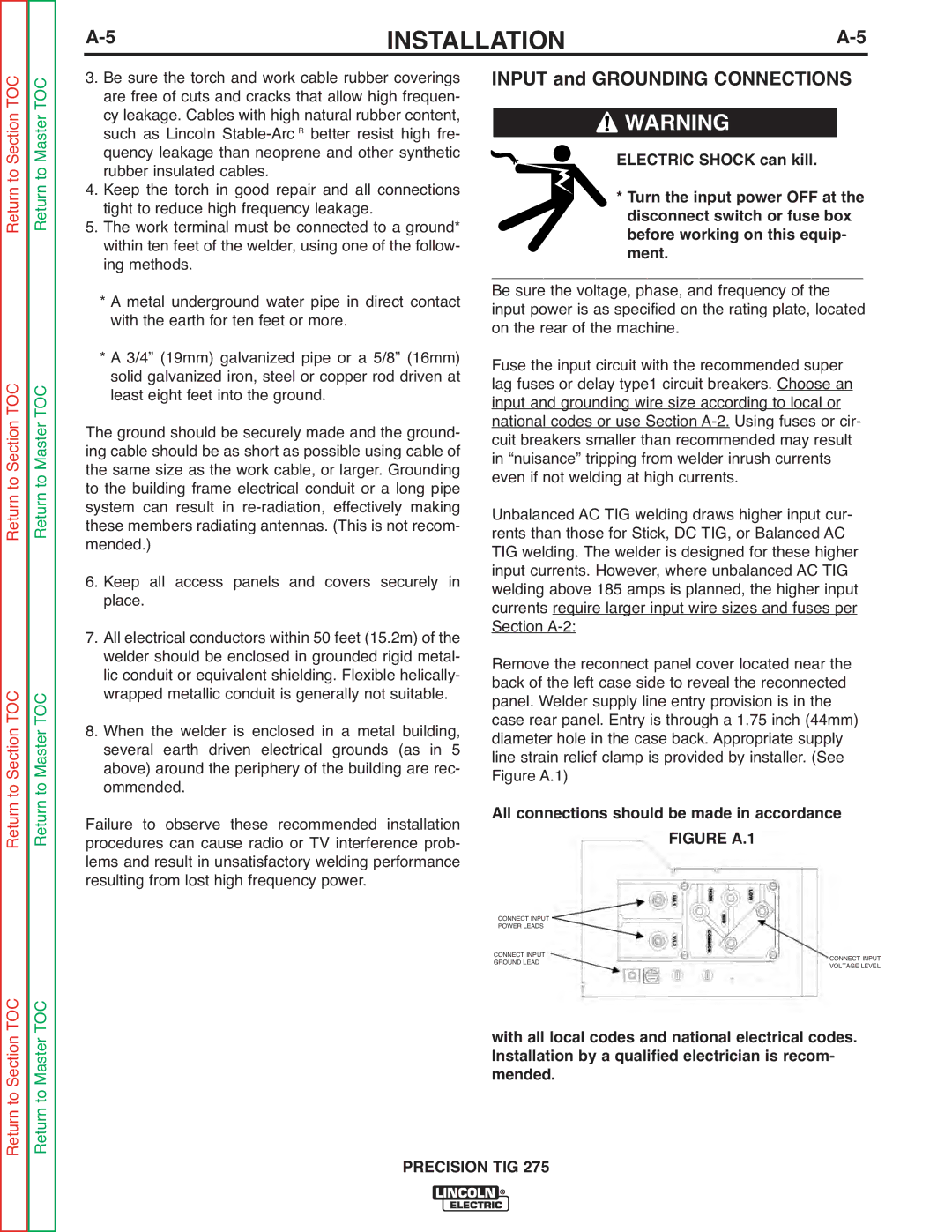
Return to Section TOC Return to Master TOC
Return to Section TOC Return to Master TOC
Return to Section TOC Return to Master TOC
Return to Section TOC Return to Master TOC
INSTALLATION | ||||||
are free of cuts and cracks that allow high frequen- | INPUT and GROUNDING CONNECTIONS |
| ||||
3. Be sure the torch and work cable rubber coverings |
|
| WARNING | |||
such as Lincoln | better resist high fre- |
|
| |||
cy leakage. Cables with high natural rubber content, |
|
|
|
|
| |
quency leakage than neoprene and other synthetic |
|
|
|
|
| |
|
| ELECTRIC SHOCK can kill. | ||||
rubber insulated cables. |
|
|
| |||
4. Keep the torch in good repair and all connections |
|
| * Turn the input power OFF at the | |||
tight to reduce high frequency leakage. |
|
| disconnect switch or fuse box | |||
5. The work terminal must be connected to a ground* |
|
| before working on this equip- | |||
within ten feet of the welder, using one of the follow- |
|
| ment. | |||
ing methods. |
| ___________________________________________ |
| |||
* A metal underground water pipe in direct contact | Be sure the voltage, phase, and frequency of the | |||||
input power is as specified on the rating plate, located | ||||||
with the earth for ten feet or more. | on the rear of the machine. | |||||
* A 3/4” (19mm) galvanized pipe or a 5/8” (16mm) | Fuse the input circuit with the recommended super | |||||
solid galvanized iron, steel or copper rod driven at | lag fuses or delay type1 circuit breakers. Choose an | |||||
least eight feet into the ground. | input and grounding wire size according to local or | |||||
The ground should be securely made and the ground- | national codes or use Section | |||||
ing cable should be as short as possible using cable of | cuit breakers smaller than recommended may result | |||||
the same size as the work cable, or larger. Grounding | in “nuisance” tripping from welder inrush currents | |||||
to the building frame electrical conduit or a long pipe | even if not welding at high currents. | |||||
system can result in | Unbalanced AC TIG welding draws higher input cur- | |||||
these members radiating antennas. (This is not recom- | rents than those for Stick, DC TIG, or Balanced AC | |||||
mended.) |
| TIG welding. The welder is designed for these higher | ||||
6. Keep all access panels and covers securely in | input currents. However, where unbalanced AC TIG | |||||
welding above 185 amps is planned, the higher input | ||||||
place. |
| currents require larger input wire sizes and fuses per | ||||
7. All electrical conductors within 50 feet (15.2m) of the | Section |
|
|
| ||
welder should be enclosed in grounded rigid metal- | Remove the reconnect panel cover located near the | |||||
lic conduit or equivalent shielding. Flexible helically- | back of the left case side to reveal the reconnected | |||||
wrapped metallic conduit is generally not suitable. | panel. Welder supply line entry provision is in the | |||||
8. When the welder is enclosed in a metal building, | case rear panel. Entry is through a 1.75 inch (44mm) | |||||
several earth driven electrical grounds (as in 5 | diameter hole in the case back. Appropriate supply | |||||
above) around the periphery of the building are rec- | line strain relief clamp is provided by installer. (See | |||||
ommended. |
| Figure A.1) |
|
|
| |
Failure to observe these recommended installation | All connections should be made in accordance | |||||
procedures can cause radio or TV interference prob- |
|
| FIGURE A.1 | |||
lems and result in unsatisfactory welding performance |
|
|
|
|
| |
resulting from lost high frequency power. |
|
|
|
|
| |
|
|
| CONNECT INPUT |
|
|
|
|
|
| POWER LEADS |
|
|
|
|
|
| CONNECT INPUT | CONNECT INPUT | ||
|
|
| GROUND LEAD | VOLTAGE LEVEL | ||
with all local codes and national electrical codes. Installation by a qualified electrician is recom- mended.
PRECISION TIG 275
